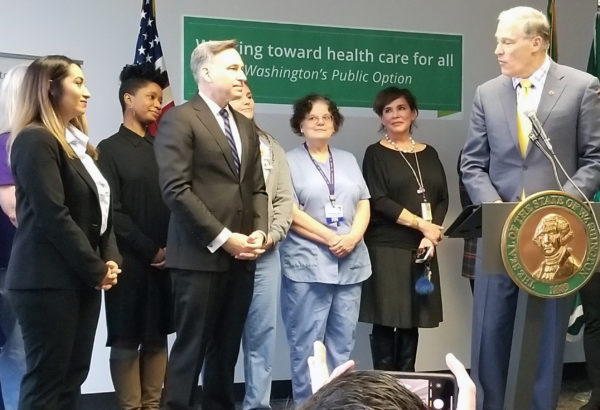On January 8, Governor Jay Inslee announced a new statewide public option health insurance proposal that will drive down costs for residents and employers. The proposal is being presented in the Legislature by Rep. Eileen Cody (D-LD34).
Called Cascade Care, it will exist alongside, and compete with, private health plans. EOI has been involved in the development of the proposal with the Washington Health Exchange.
“Over the past year, EOI has been talking with policy experts and policy makers about a pragmatic path to universal, accessible, cost-effective health care. We’ve also gone into communities across the state to hear from people about the challenges they face – and their proposed solutions. There’s lots of excitement about Cascade Care and we expect this to have a lot of momentum,” said EOI Health Policy Associate Ashley Sutton. “We’re grateful for the leadership of Governor Inslee and Representative Cody.”

Governor Inslee announcing Cascade Care. EOI Health Policy Associate Ashley Sutton is on the left.
Washington State has experienced an alarming rate of patients dropping health coverage due to skyrocketing out-of-pocket costs. Over 43,000 Washington residents dropped health insurance coverage in 2018. People under 35 years old are most likely to drop coverage.
The cost of quality health care is out of reach for Washington’s working class and middle-class families.
In 2017, 443,000 Washington residents of all ages were uninsured. The majority are working age and in middle-class households above 200 percent of the Federal Poverty Level (FPL), a commonly used benchmark to measure deep poverty and government benefits. However, overall rates of uninsurance remain highest for lower-income groups.
How Cascade Care Works
Cascade Care offers a bold solution by providing a new standard insurance plan with low out-of-pocket expenses that will control costs, encourage people to keep insurance, and lead to universal coverage.
Cascade Care utilizes current infrastructure, fully leverages federal subsidies, and institutes predictable cost transparency practices. Implementation of Cascade Care can begin in 2021, when all carriers will be required to offer at least one state-defined “standard plan” on the Washington Health Benefit Exchange. A standard plan will limit out-of-pocket costs, provide transparent and predictable cost sharing, and increase the value of federal subsidies. These plans will also cost less because they will cap reimbursement rates at Medicare rates.
“Many Washingtonians are currently paying a third of their income on health insurance premiums – and that doesn’t even include costs for care. That is unsustainable for an already-squeezed middle class. Cascade Care seeks to ensure that Washingtonians pay no more than 10 percent of their income on health premiums,” said Sutton.
By 2025, only standard plans will be offered in the Exchange. In addition, state subsidies can be phased in to enhance affordability for lower- and middle-income Washington families.
Individuals who do not have employer-provided or other health insurance already purchase insurance on the Washington State Health Benefit Exchange. Qualified people with incomes below 138 percent FPL have their costs fully covered. People between 138 and 400 percent FPL also may receive federal subsidies for premiums through the exchange, with the subsidy level declining as income rises.
Nevertheless, Washington residents with incomes above 200 percent FPL can spend about one third of their income on premiums and deductibles, in addition to other out-of-pocket costs. Lower income households that do not receive subsidies may pay half or more on premium and deductible costs.
There will be no income qualifier for a Cascade Care plan, and Cascade Care will expand subsidies to include more of the middle class. People who were previously eligible for federal subsidies under the Affordable Care Act will still be eligible for these subsidies.
Under the current system, Washington’s residents’ needs are not being met. By improving affordability, Cascade Care expands health care access and affordability to individuals and families struggling to make ends meet. Businesses, individuals, and state and local governments will all benefit from lower costs and better health outcomes. Cascade Care launches Washington State on the path to achievable universal care.
Cascade Care will improve long-term health outcomes and uplift communities all across Washington.
More To Read
February 11, 2025
The rising cost of health care is unsustainable and out of control
We have solutions that put people over profits
January 29, 2025
Who is left out of the Paid Family and Medical Leave Act?
Strengthening job protections gives all workers time they need to care for themselves and their families
November 1, 2024
Accessible, affordable health care must be protected
Washington’s elected leaders can further expand essential health care

Scott
Thank you, Thank you! Please keep this work going. And the sooner the better! This is a huge issue and meeting a huge need.
Jan 11 2019 at 5:43 AM
Karen
I’m a proponent of single payer, so this seems like a great move in that direction. I have a concern, though, about the viability of this approach. Could the limits on the cost of premiums drive insurers out of participating in the exchange? And on the costs of care, it seems that medicare coverage is sometimes inadequate so some providers may not see the patients who have Cascade Care. Is that a potential problem with this approach?
Jan 14 2019 at 11:20 PM
Alan Richrod
It appears this falls way short of the Whole Washington plan and will still leave people out. But despite the subtitle, it still doesn’t actually explain how the plan works. WAY more information is needed.
Jan 15 2019 at 12:13 AM